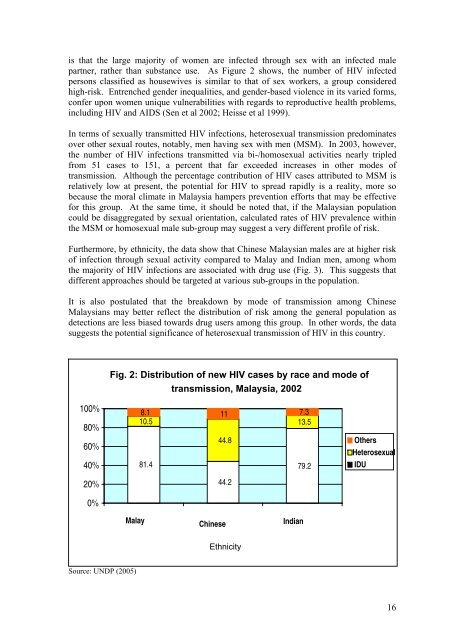Download this publication - AIDS Data Hub
Download this publication - AIDS Data Hub
Download this publication - AIDS Data Hub
Create successful ePaper yourself
Turn your PDF publications into a flip-book with our unique Google optimized e-Paper software.
is that the large majority of women are infected through sex with an infected malepartner, rather than substance use. As Figure 2 shows, the number of HIV infectedpersons classified as housewives is similar to that of sex workers, a group consideredhigh-risk. Entrenched gender inequalities, and gender-based violence in its varied forms,confer upon women unique vulnerabilities with regards to reproductive health problems,including HIV and <strong>AIDS</strong> (Sen et al 2002; Heisse et al 1999).In terms of sexually transmitted HIV infections, heterosexual transmission predominatesover other sexual routes, notably, men having sex with men (MSM). In 2003, however,the number of HIV infections transmitted via bi-/homosexual activities nearly tripledfrom 51 cases to 151, a percent that far exceeded increases in other modes oftransmission. Although the percentage contribution of HIV cases attributed to MSM isrelatively low at present, the potential for HIV to spread rapidly is a reality, more sobecause the moral climate in Malaysia hampers prevention efforts that may be effectivefor <strong>this</strong> group. At the same time, it should be noted that, if the Malaysian populationcould be disaggregated by sexual orientation, calculated rates of HIV prevalence withinthe MSM or homosexual male sub-group may suggest a very different profile of risk.Furthermore, by ethnicity, the data show that Chinese Malaysian males are at higher riskof infection through sexual activity compared to Malay and Indian men, among whomthe majority of HIV infections are associated with drug use (Fig. 3). This suggests thatdifferent approaches should be targeted at various sub-groups in the population.It is also postulated that the breakdown by mode of transmission among ChineseMalaysians may better reflect the distribution of risk among the general population asdetections are less biased towards drug users among <strong>this</strong> group. In other words, the datasuggests the potential significance of heterosexual transmission of HIV in <strong>this</strong> country.Fig. 2: Distribution of new HIV cases by race and mode oftransmission, Malaysia, 2002100%80%60%40%20%0%8.1 11 7.310.513.544.881.479.244.2OthersHeterosexualIDUMalayChineseIndianEthnicitySource: UNDP (2005)16















